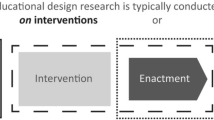Abstract
The proliferation of mobile technologies and apps raises questions for researchers in the field of educational technology. Many apps are marketed as having impact on learning or therapeutic outcome in populations with additional support needs. This paper briefly outlines three possible academic responses to the rise of therapeutic technologies for vulnerable populations. These are: reviewing existing scientific evidence to inform design; knowledge exchange with consumers and commercial partners; and rigorous evaluation of technologies in an academic context. The examples are drawn from autism research, but have implications for the evaluation of technologies generally, and for provision of guidance to various user communities. Better communication and closer working between developers, researchers and consumers is necessary to ensure relevant research outcomes and evidence-based practice in educational technology. The paper concludes with concrete recommendations for researchers in Education, Psychology, or Computer Science in carrying out work relevant to commercial enterprise and consumers.
Similar content being viewed by others
References
APA (2013). Dsm 5, American Psychiatric Association.
Baird, G., Simonoff, E., Pickles, A., Chandler, S., Loucas, T., Meldrum, D. & Charman, T. (2006). Prevalence of disorders of the autism spectrum in a population cohort of children in south thames: The special needs and autism project (snap) Lancet 368(9531): 210-215.
Durkin, K., Whitehouse, A., Jaquet, E., Ziatas, K., & Walker, A. J. (2010). Cell phone use by adolescents with Asperger syndrome. Research in Autism Spectrum Disorders 4: 314-318.
Elsabbagh, M., Divan, G., Koh, Y.J., Kim, Y.S., Kauchali, S., Marcin, C., . . . Wang, C. (2012). Global prevalence of autism and other pervasive developmental disorders. Autism Research 5(3): 160-179.
Fletcher-Watson, S. (2014). A targeted review of computer-assisted learning for people with autism spectrum disorder: Towards a consistent methodology. Review Journal of Autism and Developmental Disorders: 1(2), 87-100.
Fletcher-Watson, S. & Durkin, K. (2015). Uses of new technologis by young people with neurodevelopmental disorders: Motivations processes and cognition. In D. Riby & J. ven Herwergen (eds.) Neurodevelopmental Disorders: Research Challenges and Solutions, Oxford University Press, Oxford UK.
Fletcher-Watson, S., Pain, H., Hammond, S., Humphry, A. & McConachie, H. (2014). Designing an ipad app to engage children with autism. Journal of Human Computer Interaction submitted.
Frauenberger, C., Good, J. & Keay-Bright, W. (2011). Designing technology for children with special needs: Briding perspectives through participatory design. CoDesign 7(1): 1-28.
Gillespie-Smith, K. & Fletcher-Watson, S. (2014). Designing AAC systems for children with autism: Evidence from eye tracking research. Augmentative and Alternative Communication(0): 1-12. DOI: 10.3109/07434618.2014.905635
Grynszpan, O., Weiss, P.L., Perez-Diaz, F. & Gal, E. (2013). Innovative technology-based interventions for autism spectrum disorders: A meta-analysis. Autism 18(4): 346-361.
Guha, M.L., Druin, A. & Fails, J.A. (2012). Cooperative inquiry revisited: Reflections of the past and guidelines for the future of intergenerational co-design. International Journal of Child-Computer Interaction 1(1): 14-23.
Lahm, E.A. (1996). Software that engages young children with disabilities. Focus on Autism and Other Developmental Disabilities 11(2): 115-124.
Mazurek, M.O. & Wenstrup, C. (2012). Television, video game and social media use among children with asd and typically developing siblings. Journal of Autism and Developmental Disorders: 1-14.
Nation, K. & Penny, S. (2008). Sensitivity to eye gaze in autism: Is it normal? Is it automatic? Is it social? Development and Psychopathology 20: 79-97.
Orsmond, G.I. & Kuo, H. (2011). The daily lives of adolescents with an autism spectrum disorder: Discretionary time use and activity partners. Autism 15(5): 579-599.
Pennington, R.C. (2010). Computer-assisted instruction for teaching academic skills to students with autism spectrum disorders: A review of literature. Focus on Autism and Other Developmental Disabilities 25(4): 239-248.
Porayska-Pomsta, K., Frauenberger, C., Pain, H., Rajendran, G., Smith, T., Menzies, R., . . . Lemon, O. (2011). Developing technology for autism: An interdisciplinary approach. Personal and Ubiquitous Computing.
Rajendran, G. (2013). Virtual environments and autism: A developmental psychopathological approach. Journal of Computer Assisted Learning 29(4): 334-347.
Ramdoss, S., Lang, R., Mulloy, A., Franco, J., O’Reilly, M., Didden, R. & Lancioni, G.E. (2011a). Use of computer-based interventions to teach communication skills to children with autism spectrum disorders: A systematic review. Journal of Behavioural Education 20: 55-76.
Ramdoss, S., Machalicek, W., Rispoli, M., Lang, R. & O’Reilly, M. (2012). Computerbased interventions to improve social and emotional skills in individuals with autism spectrum disorders: A systematic review. Developmental Neurorehabilitation.
Ramdoss, S., Mulloy, A., Lang, R., O’Reilly, M., Sigafoos, J., Lancioni, G.E., . . . El Zein, F. (2011b). Use of computer-based interventions to improve literacy skills in students with autism spectrum disorders: A systematic review. Research in Autism Spectrum Disorders 5: 1306-1318.
Shane, H. & Albert, P. (2008). Electronic screen media for persons with autism spectrum disorders: Results of a survey. Journal of Autism and Developmental Disorders 38(8): 1499-1508.
Author information
Authors and Affiliations
Corresponding author
Rights and permissions
About this article
Cite this article
Fletcher-Watson, S. Evidence-based technology design and commercialisation: Recommendations derived from research in education and autism. TECHTRENDS TECH TRENDS 59, 84–88 (2015). https://doi.org/10.1007/s11528-014-0825-7
Received:
Published:
Issue Date:
DOI: https://doi.org/10.1007/s11528-014-0825-7




